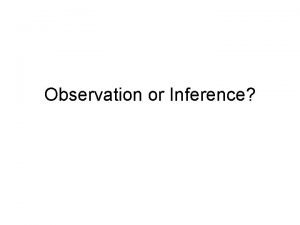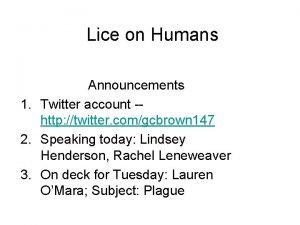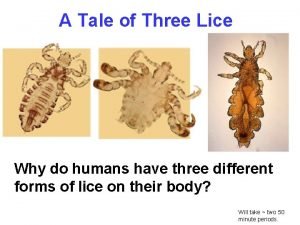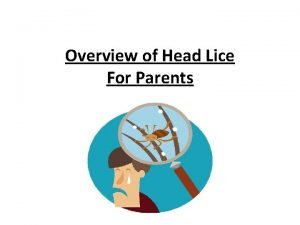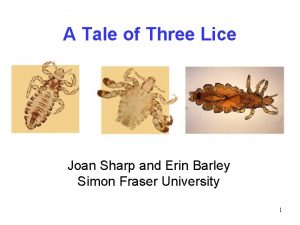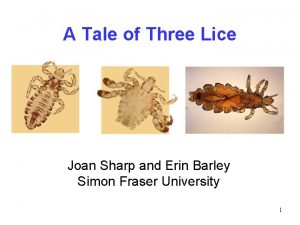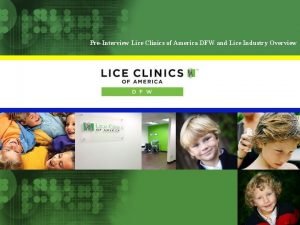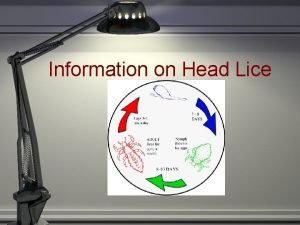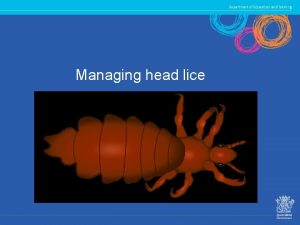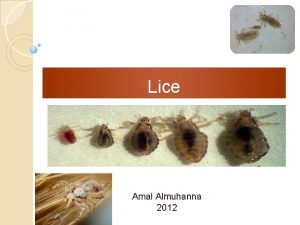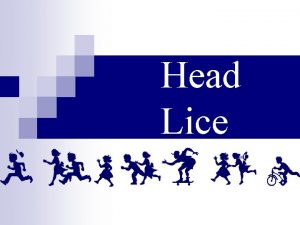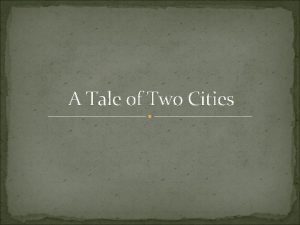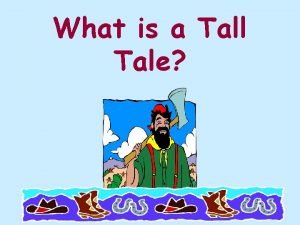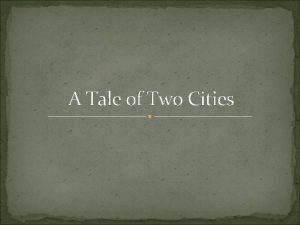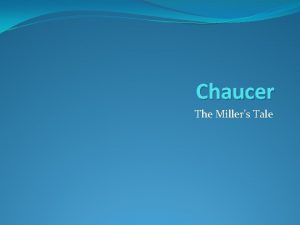A Tale of Three Lice Why do humans
























- Slides: 24

A Tale of Three Lice Why do humans have three different forms of lice on their body? Will take ~ two 50 minute periods.

an s m Hu ra ng ut an s G or illa s Ch im ps O ib bo G The human lineage and the chimp lineage diverged ~6 million years ago. ns Hominins Homo sapiens evolved ~200, 000 years ago A hominin is any species that is more closely related to a human than a chimpanzee (Ex: Australopithecus and Homo). 1. Where would you place hominins on the cladogram (redraw the cladogram on your page)?

Limitations of the Fossil Record There are questions about hominins that the fossil record cannot answer, such as: -When did hominins lose their body hair? - When did hominins begin to wear clothes? 2. Think of another question about hominins that cannot be answered with fossils.

How can we answer these questions? Examine patterns of hominin distribution and past climate maps – This might be helpful, but won’t provide direct evidence Look for tools used to make clothes – The oldest needles are ~40, 000 years old, but only provide a minimum age for clothing Bone needle, 40, 000 YA 3. How would a climate map help you answer the question of when hominins started wearing clothes?

Can lice help? Can lice tell us when hominins lost their body hair and/or started wearing clothing?

A tale of three lice • Lice are highly specialized blood sucking parasites that live on a single host species. • Each of our ape relatives hosts one louse species, but humans host three types of lice. The head louse, Pediculus humanus capitus The pubic louse, Phthirus pubis The body louse, Pediculus humanus corporis

The origin of head lice Human head lice and chimp lice belong to the same genus, but are different species. 3. Discuss and propose a reason for why two separate lineages of lice have evolved. Pediculus humanus, left, the human head louse, and Pediculus schaeffi, the chimp louse. Photo by Julie Allen Source: http: //news. illinois. edu/news/14/0108 lice_Kevin. Johnson. ht ml

Co-speciation hypothesis: Human head and chimp lice lineages diverged at the same time that hominins and ancestral chimps diverged. Human Chimp Gorilla Orangutan Gibbon Old world monkey 30 25 20 15 10 million years ago 5 0

To test this hypothesis: – Compare DNA of human head lice to DNA of chimp lice at one nuclear and one mitochondrial gene to estimate when they last shared a common ancestor. Results: A DNA comparison suggests the most recent common ancestor of chimp lice and human head lice lived ~6 million years ago. 4. Why is 6 MYA a significant period of time?

The origin of pubic lice Consider human head lice and pubic lice. 5. Compare the morphology of the two types of louse. Why do you think these two species diverged?

A possible origin of pubic lice New niche hypothesis: – Human pubic and head lice lineages diverged because hominins lost their body hair and developed two hair niches. 6. Define “niche. ” 7. How would you test this hypothesis?

To test this hypothesis: First, compare DNA of human pubic lice to human head lice at one nuclear and one mitochondrial gene to estimate when they last shared a common ancestor. 8. What would you predict, given the new niche hypothesis? Human head and pubic lice lineages diverged from a common ancestor approximately: A. 25 million years ago, when ape and monkey lineages split. B. 6 million years ago, when human and chimp lineages split. C. 6 million years ago or less, on a hominin host.

9. Create a model (drawing) of how divergent speciation would have resulted in head lice and pubic lice, with the common ancestor of the body louse found in chimpanzees. 10. Would this be considered sympatric speciation or allopatric speciation? Defend your choice.

Results: DNA comparison suggests the most recent common ancestor of human head lice and human pubic lice lived ~12 million years ago. (Humans and chimps diverged 6 million years ago. ) Conclusion: Human head and pubic lice did not diverge on a hominin from the same ancestor (chimp louse).

11: Why do we conclude that human head and pubic lice did not diverge on a hominin? A. Human head and pubic lice lineages diverged well before hominins evolved ~6 million years ago. B. Humans had body hair well after 12 million years ago. C. The fossil record does not show pubic lice on people that long ago.

12. Suggest an alternative hypothesis for the origin of pubic lice. If they didn’t come from regular (body) lice, where did they come from? This phylogenetic tree might provide a clue.

Surprise! Human pubic lice (Phthirus pubis) belong to the same genus as gorilla lice (Phthirus gorillae). DNA comparisons show that human pubic lice and gorilla lice last shared a common ancestor 3 -4 million years ago.

14. Redraw this phylogenetic tree, indicate where you would place Phthirus gorillae.

What about body lice? • Human head and body lice are different morphotypes belonging to the same species. • Human body lice live on clothing and move onto skin up to 5 times a day to feed. The head louse, The body louse, Pediculus humanus capitus corporis 15. What word can you substitute for morphotype that we have used in class?

Third niche hypothesis: Human body lice arose because humans started to wear clothing. 16. What is the “third niche”?

17: What would you predict, given the third niche hypothesis? The last common ancestor of human head and body lice lived: A. Approximately 6 million years ago, on the common ancestor of humans and chimps. B. 1 -2 million years ago, on a hominin that had lost some or all of its body hair. C. Less than 100, 000 years ago, on a modern human.

Results: A DNA comparison suggests the most recent common ancestor of human body lice lived less than 72, 000 years ago. Conclusion: Human body lice arose from human head lice on Homo sapiens, suggesting that clothing might have arisen ~72, 000 years ago. 18. Create a phylogenetic tree showing the relationship between chimpanzee lice, head lice, body lice and pubic lice.

Final Analysis Reddit has a category labeled ELI 5, which stands for: “explain like I’m five: 19. Write an explanation for why humans have 3 different forms of lice, #ELI 5 is not about explaining things on a literal five year old level! 6, don't dumb your explanation down to be comprehendible by a five year old. Use layman-friendly vocabulary (or define technical terms), and use analogies if they fit, but don't try to force anything. Just explain it to someone who wouldn't be familiar with it.

Every case study, project, or lab we do will have some test question associated with it, either a short answer or multiple choice question. 20. Write a multiple choice question and a short answer question related to this investigation. (Think of what kinds of questions you have seen on previous tests. )
 Why why why why
Why why why why Characteristics of folk literature
Characteristics of folk literature Three different ways humans regionalize the earth
Three different ways humans regionalize the earth Can we live without minerals
Can we live without minerals What do fossils tell us about the past
What do fossils tell us about the past Marshy area
Marshy area Dont ask
Dont ask Sveti plam tekst
Sveti plam tekst Lice in the trenches
Lice in the trenches Are sewer lice edible
Are sewer lice edible Twitter
Twitter Ja dolazim pred tvoje lice
Ja dolazim pred tvoje lice What does a baby lice look like
What does a baby lice look like Program za frizure prema obliku lica download
Program za frizure prema obliku lica download Vrste listova
Vrste listova Frizure za okruglo lice i visoko celo
Frizure za okruglo lice i visoko celo Body lice pictures
Body lice pictures Sea lice new jersey
Sea lice new jersey Msfi za msp
Msfi za msp Lice
Lice Rašljike
Rašljike Glagoli i glagolski oblici
Glagoli i glagolski oblici Lice
Lice Lice
Lice Vadozna zona
Vadozna zona









